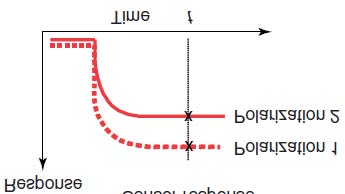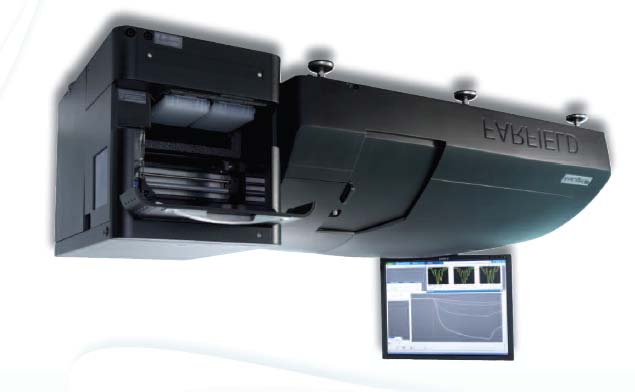Optical waveguides as a basis for a sensitive detector system (Farfield)
Submitting Institution
University of DurhamUnit of Assessment
PhysicsSummary Impact Type
TechnologicalResearch Subject Area(s)
Physical Sciences: Optical Physics, Other Physical Sciences
Chemical Sciences: Physical Chemistry (incl. Structural)
Summary of the impact
Research in Durham Physics Department on optical waveguides was used to
build a novel interferometer which can measure real time changes in
dimension and density of a thin film adsorbed on a sensor chip. This has
multiple applications in surface science and biophysics, e.g. in measuring
conformal and other structural changes in proteins as they interact with
drug candidate molecules. The device was developed as a commercial product
by a spin-out company, Farfield Sensors, which sold the interferometers to
research institutes and industry. The Farfield Group was bought in 2010 by
Biolin Scientific for £2.5M.
Underpinning research
Dr Graham Cross has longstanding research interests in optical waveguide
photonic devices. In the late 1990's he was experimenting with waveguides
made from new polymeric materials which had just become available as these
have lower dielectric permittivity and so can carry higher bandwidth
signals. He was approached by Mr Neville Freeman from GEC-Marconi, who was
also using polymers but for a rather different application in vapour
sensing. He was using the change in polymer conductivity to measure the
amount of gas absorbed, but found that this was neither sensitive nor
robust. Instead, he wanted to try to use the change in refractive index of
the polymer to trace the gas absorption. Interferometry is the most
sensitive way to measure the change in any optical property and Dr Cross's
waveguide work immediately suggested a practical experimental technique.
Dr Cross designed a system where each waveguide was a water absorbing
polymer, separated by an insulating layer of water impervious polyolefin,
all mounted on a layer of glass. Each waveguide disperses the light at the
end, so they act as a Young's slit experiment. As the upper layer is
exposed to water vapour, its refractive index changes and the phase of the
light in the upper waveguide changes relative to that in the lower
reference beam. This offset in the interference fringes in the far field
(hence the company name) gives a very sensitive and robust way to measure
the amount of water vapour absorbed onto the top polymer, to the extent
that it could be followed in real time [1].
The initial device was specific to water as the polymer would not
necessarily absorb other substances of interest. However, Dr Cross
realised that the idea could be extended to any material as the light
field is not wholly confined within the waveguide but decays exponentially
away from the boundary. This part of the optical field, known as the
evanescent (vanishing) field, will interact with any ultra-thin film of
material placed on top of the upper waveguide via exciting bound or
partially bound optical modes. The interaction alters the speed of
propagation ("phase velocity") in the sensing waveguide relative to the
lower reference waveguide, again giving an offset to the interference
fringes. This meant that the polymer materials were not required at all
for the waveguides, and more robust structures could be built from silicon
oxy-nitride. (Fig 1, [2]).
 Fig 1 Schematic design for the instrument with silicon oxynitride layer waveguides
Fig 1 Schematic design for the instrument with silicon oxynitride layer waveguides
 Fig 2: Change in response with polarization state
Fig 2: Change in response with polarization state
However, Dr Cross also realised that the optical modes excited by the
evanescent wave interaction are different for different polarization
modes, and this difference can be used to derive the absolute thickness of
the ultra-thin layer (Fig 2). The final design then includes a
ferroelectric liquid crystal rotator between the illuminating laser and
waveguide stack to act as a switchable half wave plate. The two
polarization measures are taken at a typical rate of 50Hz, tracking
thickness of the layer on timescales of 20ms [2]. Fast tracking of
changing shape is especially important for biomolecules, as the shape of
proteins is as important as their chemical composition in determining
their characteristics. This paper demonstrated the technique by measuring
the thickness of an adsorbed layer of the rigid protein streptavidin as it
developed in real time [2].
The techniques are equally important in surface science applications. The
team used a thin film of tetraethylene glycol monododecyl ether (C12E14),
a well characterized non-ionic surfactant which is commonly used in
industrial formulations, and showed that the adsorbed layer thickness
increases as the surfactant concentration increases. This suggests that
the surfactant molecules adopt a prone attitude at low concentrations,
resulting in thin, relatively dense layer coverage, changing to a more
upright stance at higher concentrations. This is in good agreement with
previous neutron reflection results [3]. The sensitivity is such that it
can also be used to follow the surface changes during formation of a layer
of liquid crystal [4].
References to the research
[2] A new quantitative optical biosensor for protein characterisation
Cross G.H., Reeves A.A., Brand S., Popplewell J.F., Peel, L.L., Swann
M.J., Freeman N.J., Biosensors and Bioelectronics, 19, 383 (2003)
113 citations in web of science
[3] The
metrics of surface adsorbed small molecules on the Young's fringe
dual-slab waveguide interferometer Cross, G.H., Reeves, A.,
Brand, S., Swann, M.J., Peel, L.L., Freeman, N.J. and Lu, J.R. J.
Phys. D (Appl. Phys.), 37, 74 (2004) 61 citations in web of science
The quality of the research is
also evidenced by over 100 publications in the refereed literature which
use Farfield Dual Polarization Instruments
http://www.farfield-group.com/pdfs/Farfield_Publications.pdf
Details of the impact
Cross and Freeman had very early realised that there were multiple
commercial uses within the surface science and biophysics communities of
this new, very sensitive measurement device. They co-founded Farfield
Sensors in 1997, and filed patents for the original design ideas [P1-P2].
By 2002 they had developed this into a commercial product, the AnaLight
Bio200, a Dual Polarization Interferometer (DPI) for the measurement of
real-time structural change in molecular systems [C1]. This won the
National Physical Laboratory National Measurement Award 2003 for
Innovation in Measurement, recognising Farfield's technical innovation and
impact on current industrial metrology, as well as a suite of other awards
[C2]. The company moved to purpose built premises in Crewe [C1], and in
2008 they launched a second generation instrument design, the AnaLight 4D
which could quantify the degree of order and disruption in lipid bilayers
as well as measure molecular dimensions and density on surfaces. This new
tool generated substantial interest and the company doubled its turnover
in 2008, having its best year ever [C3]. It extended its customer base to
17 countries, recruiting a new Far East agent and a new member of the core
scientific staff [C1].
Two of the machines were bought by P&G, a US company with $80Billlion
turnover in consumer products. An example project was to test different
dishwasher detergents for their rinse time. A faster rinse reduces the
water usage, leading to environmental gains, but the detergent needs to be
completely removed in order to leave glasses `squeaky clean', a criteria
which is especially important in Japan. P&G used the DPI to
characterise the maximum surface layer of detergent required for it to be
classed as `squeaky clean' (the first reliable automated predictive test
for this), and so were able to develop faster rinse formulations. The
Analytical GCO, P&G Newcastle, identified the impact to the company `As
a result, 2 head counts in Product Design were freed up to do other
work. More importantly, the insights gained via understanding the phase
behaviour at interfaces explains why some formulations rinse off more
slowly than others...faster rinsing formulations for Japan Joy have been
identified and launched in the market and keep our business in Japan
growing.' [C4]
Applications in biophysics include drug discovery and development as the
instrument is sensitive enough to track the response of a protein to a
potential drug in real time and without any additional tagging of the
molecules which could disrupt the response. Farfield was a partner in the
3 year European FP7 program ASMENA (2008-11) to develop new platforms for
drug screening and analytical profiling based on in vitro measurements of
the functional and conformal change in membrane proteins [C5]. Similar
pan-European projects include the SABIO collaboration to develop a
diagnostic test for Hepititis A, B and C [C6], and the INTOPSENS project,
funded under the FP7 HealthCompetence programme, to demonstrate a compact
polymer and silicon-based CMOS-compatible photonics sensor system for a
rapid diagnostic test for sepsis at `point of care' [C7]. They are also
part of the NEURASYNC network to study Parkinson's disease (PD). This is
the second most common neurodegenerative disorder, characterized
pathologically by the accumulation of aggregated conformations of the
presynaptic protein alpha-synuclein. Farfield's role was to use the
AnaLight DPI for state of the art in vitro assays with biomarkers and
experimental therapeutics targeting alpha-synuclein [C8].
In 2009, the company took its sensor fabrication to Inex, at
Newcastle-upon-Tyne in order to move from a 4" to a 6" process and it
extended its range of chip surfaces. It was accepted into the North West
England High Growth business support programme. There was expansion of
bioscience-based sales activity in the form of a co-marketing agreement
with IdentiGen in Germany and the customer base extending to 19 countries
with first-time installations in Korea and the Kingdom of Saudi Arabia
[C1]. The company took on a new postdoc in 2010 and launched the Farfield
AnaLight 4D Workstation, allowing combined studies of affinity,
kinetics, conformation and thermodynamics of biomolecules (Fig 4 [C9]).
 Fig 3: AnaLight 4D workstation
Fig 3: AnaLight 4D workstation
However, the worsening economic climate brought difficulties for the
company and it was bought out in April 2010 by the publically quoted
Swedish scientific instrument supplier Biolin Scientific, who acquired all
existing shares in the Farfield Group for £2.5M [C10]. Farfield continued
to market and sell under the Farfield brand worldwide, remaining a
separate product company within the Biolin organisation. All Farfield
staff were retained after the acquisition [C10] and, indeed, three new
core staff, a Product development Manager, a Business development Manager
and an application specialist, were subsequently recruited [C11].
Iberlaser SA took on representation of Farfield in Spain, and Farfield
relocated to new premises at Manchester Airport with improved laboratory
and training facilities. Automation was enhanced during the year with the
Dual Plate Autosampler, the customer base expanded to 20 countries, and
Biolin Inc, the US division of Biolin, took on a new post-doctoral
scientist to support the Dual Polarisation Interferometry. However, Biolin
took the strategic decision to discontinue the manufacture and sales of
the Dual Polarisation Interferometer on December 30th 2011, though the
company has made the commitment to support existing customers up till the
end of December 2016 [C12].
Despite its demise, the instrument nevertheless has made a significant
contribution to biosensing and the surface science sectors, and there
remain scores of instruments in use around the world.
Sources to corroborate the impact
[C1] Farfield-Group history
http://www.farfield-group.com/company_history.asp
[C2] Farfield awards
http://www.farfield-group.com/company_history_awards.asp
[C3] Financial reports from companies house Filed with evidence
[C4] Quote from Dr Eric Robles (Analytical GCO, P&G Newcastle
Innovation Centre) Filed with evidence
[C5] ASMENA collaboration 2008-2011
http://www.farfield-group.com/readstory.asp?sid=106&ln=5.0.1
[C6] SABIO Hepititis test: 2006-2009
http://www.farfield-group.com/readstory.asp?sid=90&ln=5.0.3
[C7] INTOPSENS collaboration
http://www.farfield-group.com/readstory.asp?sid=101&ln=5.0.1
[C8] Neurasync network for Parkinson's disease 2009-2013
http://www.farfield-group.com/readstory.asp?sid=105&ln=5.0.1
[C9] AnaLight 4D workstation brochure
http://www.farfield-group.com/pdfs/AnaLight_4D_workstation.pdf
[C10] biolin takeover
http://www.farfield-group.com/readstory.asp?sid=110&ln=5.0.0
[C11] new staff
http://www.farfield-group.com/readstory.asp?sid=112&ln=5.0.0
[C12] Biolin discontinue DPI
http://www.farfield-group.com/readstory.asp?sid=118&ln=5.0
[P1] Published patent: A chemical sensor. Freeman N.J. and Cross G.H.,
1998 WO/1998/022807
[P2] Published patent: Sensor Assembly. Cross, G.H., Freeman, N.J. and
Swann, M.J. 2001 WO-A-01/36946